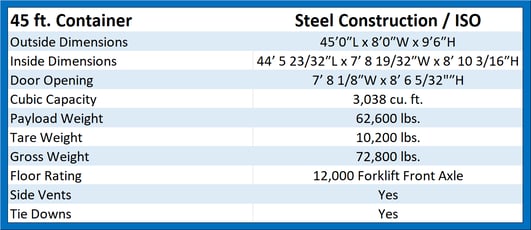Truckload• Intermodal Transportation• Logistics & Supply Chain• International & Cross Border Logistics
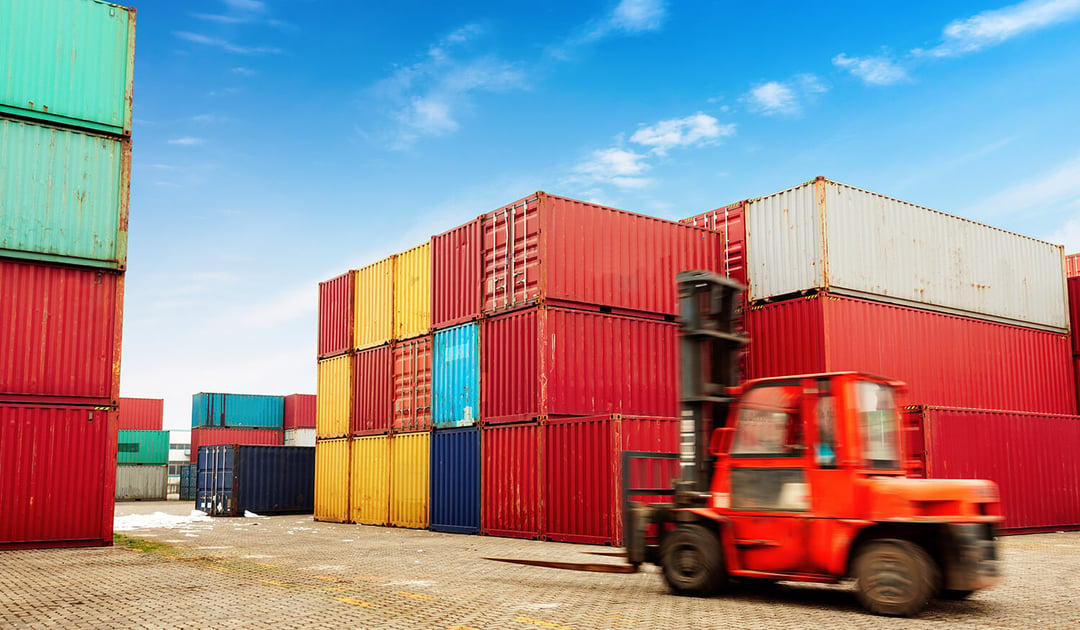
Intermodal shipping is a freight service that involves using two or more freight modes to move product through a company's supply chain. And to do so, the intermodal container is a vital component of this shipping process. This article will go over both international and domestic containers - where international intermodal containers are used primarily for ocean freight shipments and domestic intermodal containers are used throughout North America as a competitive alternative to shipping freight via truckload.
Additionally, we'll provide a deeper understanding of how ocean ISO intermodal containers efficiently connect the world's economies; the importance of domestic intermodal shipments as an alternative to shipping truckload in the U.S., Canada and Mexico (highlighting the sustainability and cost-effectiveness of cross border intermodal); the logistics behind moving freight through intermodal networks; and finally sharing the physical specifications of the various boxes used.
Understanding the Basics of Intermodal Containers
Intermodal may seem complex because multiple transportation modes are required to be synchronized for successful cargo movements from pick-up and delivery. In fact though, the shipping sector has asset and non-asset intermodal marketing companies (IMCs) and freight forwarders to make it easy for shippers by being the point to all communication and operational aspects, reporting and closing with a single bill.
Standardized containers facilitate the smooth transition of merchandise from ocean steamships, railways, and trucks, via cranes that simply move the cargo from one freight mode to another via the freight container.
Two of the most common intermodal container transfers for cargo shipments include:
- Lifting the ISO container from a steamship to either a railroad well car or truck intermodal chassis.
- Transferring an intermodal box from a rail well car to truck chassis.
The Evolution of Intermodal Containers
The history of modern day intermodal can be traced to the 1950s where international container shipping revolutionized how we thought about moving goods over long distances. By creating a universal size and shape for cargo containers for what is now known as ISO standards, International Organization of Standardization, the industry enabled equipment from different companies and countries to handle cargo efficiently.
How Intermodal Containers Connect the World
If you've ever wondered how products are imported intact to your local store, whether they're produce, apparel, electronics or similar items, thank intermodal shipping containers.
The process involves loading these versatile freight carriers onto container ships for the water transportation segment of a shipment lane that traverses oceans before being transferred onto rail or truck chassis for inland distribution.
Blending various transport methods not only streamlines freight movements, but also slashes the expenses tied to repeatedly dealing with goods during their transit. Taking the long haul portions of a freight lane and putting them on the most fuel efficient freight mode - then using the flexibility of truckload to handle final mile pick-ups and deliveries - creates a high-value transaction at the least cost and most sustainable supply chain option.
Types and Specifications of Intermodal Containers
Intermodal containers come in two versions, international and domestic. The international intermodal boxes come in a variety of lengths ranging from 20' to 53' and are built to endure extensive travels over oceans and landmasses.
About International Ocean Containers
International containers traveling on cargo ships, also called ISO containers, come in three sizes: 20', 40' and 45'. The 40' and 45' containers also have high cube (HC) size options for additional cube capacity. Forty-five foot containers are more difficult to come by as they are exiting fleets in favor of the compatibility of interchange stackability on cargo ships and railroad flat cars.
Refrigerated options are available for the three different containers used in international maritime shipments. Another option for international intermodal shipping is tank containers used for shipping various non-hazardous and hazardous shipments.
One term often used when talking the total volume of international cargo moving via the ocean is TEU, which stands for 20-foot equivalent units. This standardization helps quantify volume on a cargo ship. So, when you hear a ship has a 20,000 TEU it says that there is 20,000 capacity on the cargo ship in a combination of 20' containers counted as one unit and 40' containers counted as two units.
.jpg?width=361&height=267&name=40%20Hi-Cube%20ISO%20Container%20(1).jpg)
ISO Intermodal 20 Foot Container Specifications

ISO Intermodal 40 Foot Container Specifications
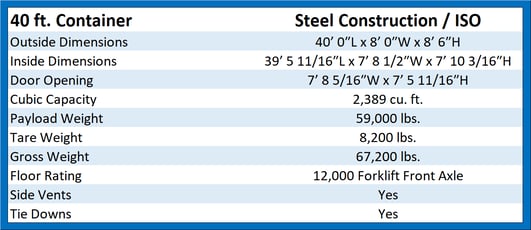
ISO Intermodal 40 Foot High Cube Container Specifications
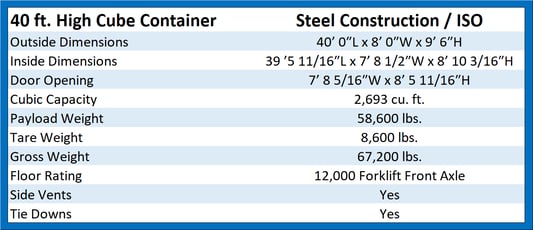
ISO Intermodal 45 Foot Container Specifications
About Domestic Intermodal Container
Domestic intermodal containers are used for shipments within North America. These containers are 53' in length, with their main purpose of competing as a more cost-effective and sustainable option than truckload shipments.
Domestic intermodal shipping containers typically move non-hazardous and hazardous dry freight, but shippers will be happy to know that there are temperature-controlled, refrigerated intermodal containers also.
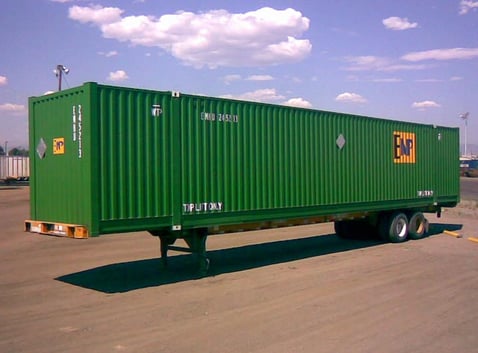
Domestic Intermodal 53 Foot Container Specifications
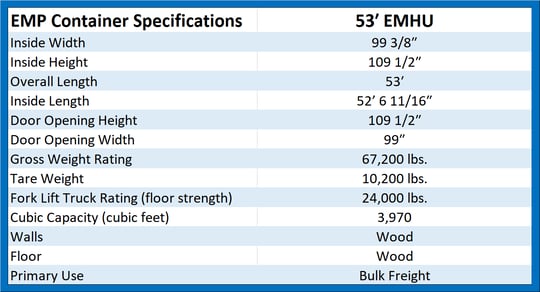
The Role of International Intermodal Containers in Cargo Shipping
Since revolutionizing how goods move across continents, nearly 90% of maritime cargo shipping operations rely on standardized international intermodal containers. The widespread adoption of these metal structure boxes highlights their crucial role in streamlining the swift flow of goods worldwide.
Cargo containers, with their unmatched ability to shift smoothly among trucks, trains, and boats, revolutionize the ease and adaptability of moving goods and have put them front and center for the globalized world economies.
The Evolution of Intermodal Containers
Since their inception in the mid-20th century, intermodal containers have undergone significant advancements. Initially designed to simplify cargo transportation post-World War II, the intermodal cargo container fleet is estimated at 737.9 thousand units in 2022, growing at a CAGR of 9.4% a year - making it a critical component in international trade.
How Intermodal Containers Connect The World
These versatile freight carriers do more than just transport goods; they connect markets globally thereby enhancing economic integration and development. Through this efficient system, products arrive at destinations faster, thus meeting market demands promptly. By knitting nations together through a web of shared logistic networks, they not only bolster trade but also strengthen international ties built on mutual dependence.
Logistics Behind Intermodal Freight Transportation
The seamless integration of multiple freight modes is at the heart of intermodal transport's appeal, offering a symphony of efficiency and cost savings. The coordination between hubs, distribution centers, and transload facilities underscores this intricate process. Prioritizing the reduction of expenses and enhancing the volume capabilities for carriers has emerged as a top concern.
Transloading of Intermodal Containers
It's estimated that roughly 35% of import container volume is transloaded into either trucks or domestic intermodal containers.
Strategically located transload points facilitate the transfer of cargo containers from one mode to another, from rail well-cars onto truck chassis or vice-versa, ensuring goods move without interruption. At the center of the operational expertise are IMCs and freight forwarders.
Benefits of Transloading:
-
Time-Sensitive Freight
- A transload facility, sometimes called a cross dock facility, is used to transfer product from the ISO container to truck for fast-paced cargo to speed up delivery.
- Domestic intermodal transit takes typically one day longer than truck, but is faster than international intermodal train routings making this mode another option for quicker transit.
-
Cost Savings
- The use of distribution centers closer to the final customer is another reason for transloading.
- An example on how transloading saves money is in the case of a cargo container being imported into the Los Angeles / Long Beach port area that contains 50% destined to customers on the West Coast and the balance to various locations that will ship out of a distribution center (DC) in the Midwest.
By transloading a portion of the container to go east and keeping the other 50% in California, the company saves on freight costs because it fulfills the West Coast orders where their customer is closer and only sends a portion to the Midwest DC for the orders east of the Mississippi.
- An example on how transloading saves money is in the case of a cargo container being imported into the Los Angeles / Long Beach port area that contains 50% destined to customers on the West Coast and the balance to various locations that will ship out of a distribution center (DC) in the Midwest.
- Other shippers save money on intermodal transportation by transloading their 40 foot international containers into 53 foot domestic containers.
- By utilizing transloading in this manner, shippers essentially gain one free container for every four shipped by consolidating into the larger 53' container.
- The use of distribution centers closer to the final customer is another reason for transloading.
-
More Precise Balance of Inventory
- Quite often consumer goods sell through at retail stores at differing levels, so to correct the inventory balance in the field, a hub group within the company monitors inventory levels and transloads product as needed to help reduce out of stock backorders or redistributing inventory later in the season.
In essence, understanding these logistics behind moving freight intermodally unveils opportunities for enhancing supply chain resilience against disruptions. At the same time, it achieves sustainability goals through reduced emissions compared to traditional road transports alone.
Advantages of Using Intermodal Transportation
Intermodal transportation captivates with its blend of streamlined operations, budget-friendliness and eco-friendly advantages. This transportation strategy combines rail, truck and ships to move freight using intermodal.
One significant advantage is the reduction in operational costs it offers shippers by leveraging the strengths of each transportation mode optimally, such as using rail for long-haul distances to capitalize on lower fuel costs. By doing so, it's possible to achieve more efficient transportation overall. Moreover, this method proves to be environmentally friendly due to reduced carbon emissions compared with road transport alone.
Merging the flexibility of truckload transportation with a commitment to sustainability from rail shipping puts a bright light on intermodal for U.S. and cross-border shipping with Canada and Mexico.
Globalization would be severely hindered if it were not for the versatility offered by utilizing standard-sized intermodal cargo containers to simplify international logistics in the global maritime industry.
Key Players and Components in the Intermodal Transportation Industry
As mentioned earlier, intermodal marketing companies (IMCs) and freight forwarders are the organizations that help capacity shippers with their intermodal shipping requirements by connecting their individual needs with those carriers that have the infrastructure and equipment.
The North American class I railroads - Union Pacific, BNSF, Norfolk Southern, CSX, CN and CPKCS - are the rails most involved in inland movement of intermodal. The rail companies own domestic intermodal containers, and operate and maintain the locomotives, railroad tracks, well rail cars, rail ramps and bridges.
Ocean carriers are similar to the railroads in that they are heavily invested in equipment where they own the steamships, cargo containers and chassis. Ocean carriers also take on long leases at the ports.
The most challenging of the various segments of intermodal is that of the dray. The dray industry is very fragmented with a great deal of capacity tied up in small companies or individual owner operators - making it a critical point every freight forwarder and IMC constantly evaluate for peak performance.
Conclusion
Hopefully, we've connected all the dots for you on this thorough exploration of the essence and pivotal significance of intermodal containers in worldwide commerce. From their evolution to the future outlook, container freight is a game-changer on cost, supply chain sustainability, and significant freight capacity.
By streamlining the transportation of products, these containers revolutionize cost-efficiency and speed in global trade. By linking different forms of transport, they shrink our planet and open up markets, making the global economy a reality.
This journey revealed how they're not just metal boxes, but the lifelines of international commerce.
In essence, understanding the intermodal container means getting a grip on how most products reach shelves worldwide. Containers carry just about any commodity from agricultural products to consumer goods to key manufacturing components.
In the end, the right freight provider partner should be able to leverage multiple modes when possible - whether land or by sea for truckload, intermodal, ocean or a combo - to get the job done in the most efficient manner. And it should incorporate the latest technology to plug in to market conditions, capacity availability, license and safety information, and shipment track and trace (shared with the shipper as well).
All of these components may sound like a big ask, but at InTek, we've got you covered. Just reach out to us, and make our Request a Quote form the last one you'll need to fill out for a long time. For more information about InTek, or logistics and supply chain issues in general, check out our Freight Guides.
Get Updates
Featured Articles
Categories
- Freight & Shipping Costs (54)
- Freight Broker (60)
- Freight Forwarder (2)
- Intermodal Transportation (184)
- International & Cross Border Logistics (43)
- Logistics & Supply Chain (420)
- Logistics Service Provider (77)
- LTL (39)
- Managed TMS (49)
- News (39)
- Supply Chain Sustainability (12)
- Transportation Management System (37)
- Truckload (122)
- Warehousing & Distribution (50)



